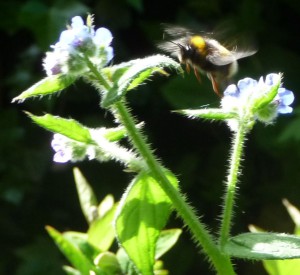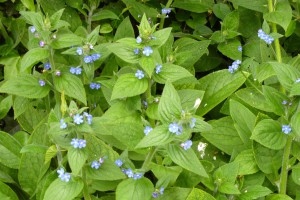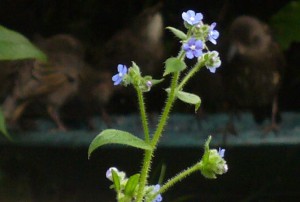GREEN ALKANET (Pentaglottis sempervirens)
SW France, Iberian Peninsula
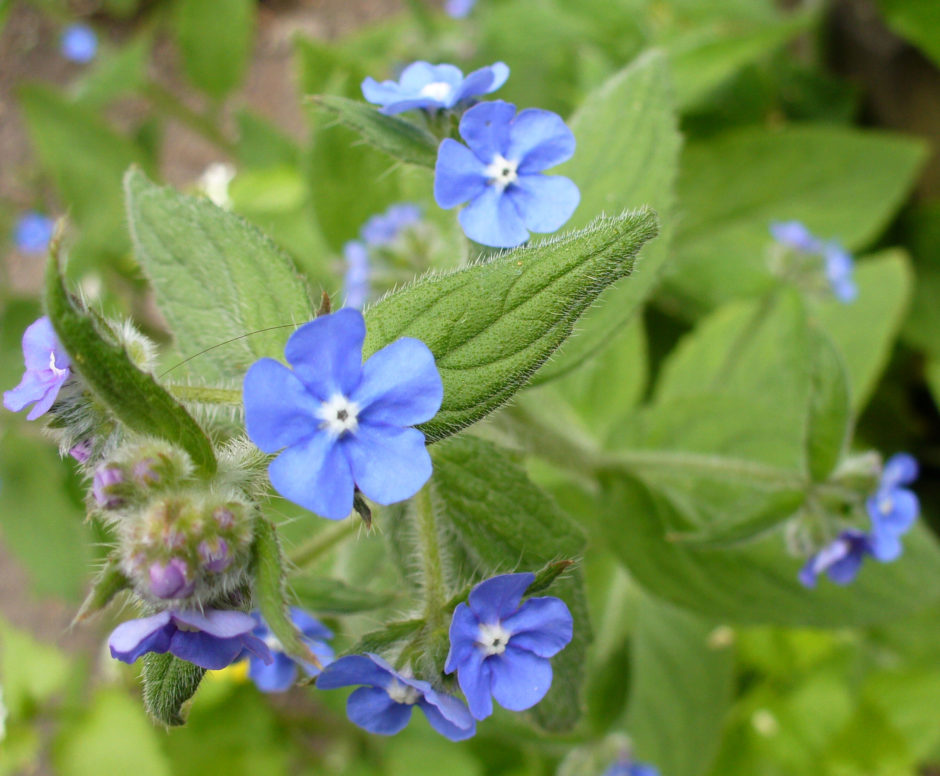
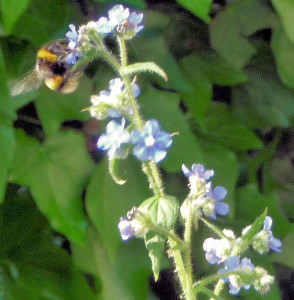
Green Alkanet, a perennial wildflower, has been in this country since at least 1700. It flourishes in damp & shady places in clay, sandy or loamy soil. Its large paddle-shaped leaves are bristly & hairy, as are its stout stems – these may grow to one metre in height. The plant’s flowers, which are an intense BLUE, may appear as early as March & bloom well into the summer.
Bees are irresistably drawn to this wildflower. They will seek out the last blooms on stems that have fallen to the ground. Even in years when bee numbers were down, some always found their way to this garden to visit the Green Alkanet. When flowering is over, the stem & withered leaves turn a crisp brown… Because bees will come to the last remaining flower, we don’t remove the unsightly old stalks until nothing is left at the top for the bees.
Seeing so many bee visitors, garden guests are likely to ask ‘What is that blue flower?’
Invasive
Pentaglottis Sempervirens has a mighty tap root. If you dig it up, any morsel of the root left in the ground will become another Green Alkanet. It is also self-seeding. Leave every last blue flower for the bees, then cut the plant down at the base.
“The RHS website recommends various strategies to get rid of Green Alkanet but I would urge you to dig up the roots and to stop the plant from seeding, rather than poison your garden with glyphosate. You can put the leaves on the compost heap, but don’t include the roots as they are likely to regrow. Alys Fowler suggests making a weed soup out of it to feed plants. Like comfrey tea, it will smell bad, but act as a great plant food. Wear gloves when handling the leaves, as the coarse hairs can cause a rash, due to structures known as cystoliths made of silicon dioxide and calcium carbonate.”
Green Alkanet, Pentaglottis Sempervirens / Jeremy Bartlett’s LET IT GROW blog
https://www.jeremybartlett.co.uk/2017/04/27/green-alkanet-pentaglottis-sempervirens/
One website, the plants for a future database, included a number of comments about this plant. In 2008 and 2009 it seems to have invaded a number of London gardens; in 2013 and 2016 border collies were seeking it out to eat the young leaves.
about us plants for a future https://pfaf.org/user/AboutUs.aspx
The Plant’s Name
The word “alkanet” derives from Middle English, from Old Spanish alcaneta, diminutive of alcana, “henna”, from Medieval Latin alchanna, from Arabic al-ḥinnā’,’henna’: The genus name Pentaglottis is Greek, meaning “five tongues”, and the species name sempervirens is Latin and means “always alive”, or “evergreen”.
https://www.7wells.co.uk/alkanet-389-p-asp
Other names: Bird’s Eye, Boraiste gorm (Irish), Buglosa (Spanish), Buglossa ovata (Italian), Buglosse toujours verte (French), Evergreen Bugloss, Femtunge (Danish), Green-leaved Perilla, Hasttunga (Swedish), Lenguaza fresca (Spanish), Olhos-de-gato (Portuguese), Overblijvende ossentong (Dutch), Pentaglottis toujours verte (French), Pheasant’s Eye, Pilatka vzdyzelena (Czech).
Wildflowers with Prickles
As a conservation volunteer, you learn that ordinary gardening gloves are inadequate for dealing with some wildflowers. At the Ecology Centre we are provided with gauntlets – tough, rugged gloves reaching almost to the elbow – for tasks involving prickly plants.
My top four wildflowers, rated for gauntlet need, thorns, prickles & pain, are
1. Bramble
2. Dog Rose
3. Teasel
4. Green Alkanet
All are worth growing for bees, if you have the space & can deal with the prickles.
